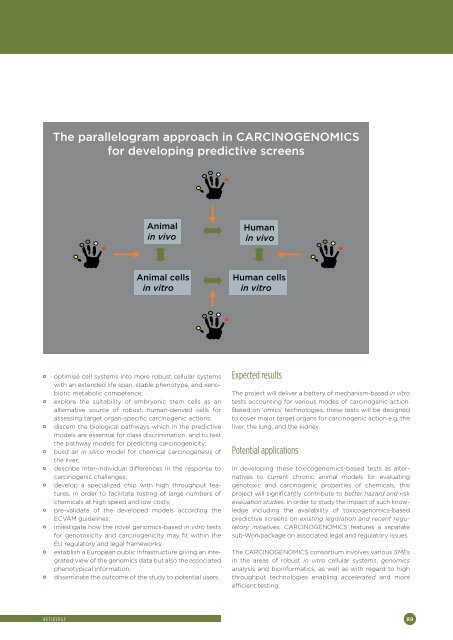You also want an ePaper? Increase the reach of your titles
YUMPU automatically turns print PDFs into web optimized ePapers that Google loves.
The parallelogram approach in CARCINOGENOMICS<br />
for developing predictive screens<br />
Animal<br />
in vivo<br />
Animal cells<br />
in vitro<br />
• optimise cell systems into more robust cellular systems<br />
with an extended life span, stable phenotype, and xenobiotic<br />
metabolic competence;<br />
• explore the suitability of embryonic stem cells as an<br />
alternative source of robust, human-derived cells for<br />
assessing target organ-specifi c carcinogenic actions;<br />
• discern the biological pathways which in the predictive<br />
models are essential for class discrimination, and to test<br />
the pathway models for predicting carcinogenicity;<br />
• build an in silico model for chemical carcinogenesis of<br />
the liver;<br />
• describe inter-individual diff erences in the response to<br />
carcinogenic challenges;<br />
• develop a specialized chip with high throughput features,<br />
in order to facilitate testing of large numbers of<br />
chemicals at high speed and low costs;<br />
• pre-validate of the developed models according the<br />
ECVAM guidelines;<br />
• investigate how the novel genomics-based in vitro tests<br />
for genotoxicity and carcinogenicity may fi t within the<br />
EU regulatory and legal frameworks;<br />
• establish a European public infrastructure giving an integrated<br />
view of the genomics data but also the associated<br />
phenotypical information;<br />
• disseminate the outcome of the study to potential users.<br />
Human<br />
in vivo<br />
Human cells<br />
in vitro<br />
Expected results<br />
The project will deliver a battery of mechanism-based in vitro<br />
tests accounting for various modes of carcinogenic action.<br />
Based on ‘omics’ technologies, these tests will be designed<br />
to cover major target organs for carcinogenic action e.g. the<br />
liver, the lung, and the kidney.<br />
Potential applications<br />
In developing these toxicogenomics-based tests as alternatives<br />
to current chronic animal models for evaluating<br />
genotoxic and carcinogenic properties of chemicals, this<br />
project will signifi cantly contribute to better hazard and risk<br />
evaluation studies. In order to study the impact of such knowledge<br />
including the availability of toxicogenomics-based<br />
predictive screens on existing legislation and recent regulatory<br />
initiatives, CARCINOGENOMICS features a separate<br />
sub-Workpackage on associated legal and regulatory issues.<br />
The CARCINOGENOMICS consortium involves various SMEs<br />
in the areas of robust in vitro cellular systems, genomics<br />
analysis and bioinformatics, as well as with regard to high<br />
throughput technologies enabling accelerated and more<br />
effi cient testing.<br />
AETIOLOGY 89
















